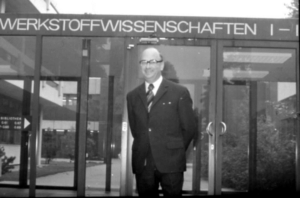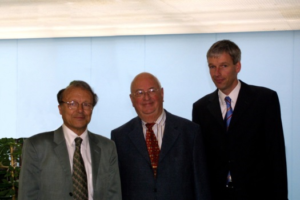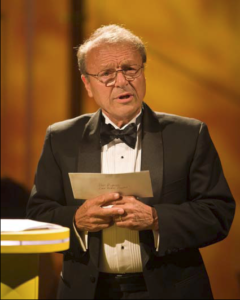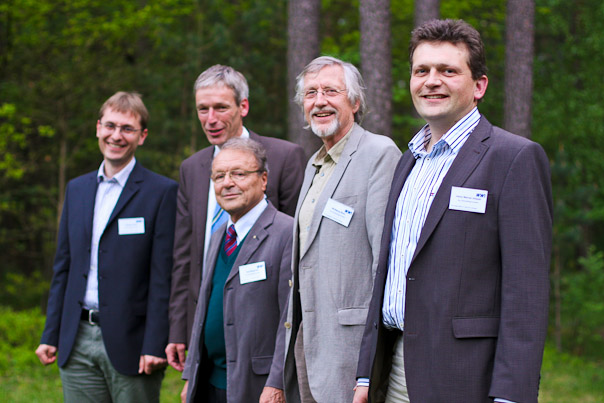History

The Chair of General Material Properties (WW I) was founded on August 09, 1965 as the first of six planned chairs in materials science with the appointment of Prof. Dr. rer. nat. Bernhard Ilschner. Ilschner was a “student” of Prof. Peter Haasen from the renowned Institute of Metal Physics at the University of Göttingen. Thus, the Chair WW I was one of the first chairs of the new Faculty of Engineering of the Friedrich-Alexander University, which was officially opened in 1966. In 1984, Prof. Dr. rer. nat. Haël Mughrabi, who came from the Max Planck Institute of Metal Physics in Stuttgart, took over the chair. The main research areas concerning strength and structure of materials, including the underlying deformation mechanisms, were continued. Additionally new topics, such as crystal plasticity, fatigue strength and X-ray analysis, were added. In 2002, Prof. Dr. rer. nat. Mathias Göken was appointed to the chair. Prof. Göken did his PhD at the Max Planck Institut für Eisenforschung in Düsseldorf under Prof. Neumann. He then worked at Saarland University and Stanford University, respectively, in the field of nanomechanics/atomic force microscopy. Nanomechanical test methods became an important addition to macroscopic mechanical test methods in almost all topics of the chair WW1.
The main activities of the chair are the research of the correlation of microstructure and mechanical properties of materials and material systems. The focus was set and still is on fundamental mechanistic questions as well as on more application-related questions of alloy development and the effect of process parameters on material properties. In particular, the development of a mechanism-based understanding of material behavior under a wide range of loading conditions and, derived from this, the targeted improvement of materials and material systems represents the core competence of the chair which has been built up over the years. The spectrum of materials has always been quite broad and ranges from steels, aluminum, titanium and magnesium alloys, nickel and cobalt-based alloys, magnesium and aluminum oxides to model material systems such as laminate materials, coatings and ionic crystals.
 The chair also has a long tradition in teaching. In the winter semester of 1965/66, Prof. Ilschner offered the first lecture in the field of materials science, “Materials Science I”. From the beginning, the lecture was intended to stand out from the established lectures elsewhere in the field of metal physics, with an orientation that conveyed the close interconnection of natural sciences and technology. The audience included students of physics and mineralogy. In the winter semester 1966/67, the lecture “Physics of Materials” was added to the program. In the course of time, this has evolved into the lecture “Materials and their Structure”, which in its present form teaches the fundamentals of materials science to students in their 1st semester. Over time, the range of courses has become increasingly broad and many specialized lectures have been created, such as the lectures “High Temperature Materials”, “Fatigue Behavior of Metallic Materials”, “Intermetallic Alloys”, “Hardening Mechanisms”, “Tribology and Surface Technology”, “Micro- and Nanomechanics”, etc.
The chair also has a long tradition in teaching. In the winter semester of 1965/66, Prof. Ilschner offered the first lecture in the field of materials science, “Materials Science I”. From the beginning, the lecture was intended to stand out from the established lectures elsewhere in the field of metal physics, with an orientation that conveyed the close interconnection of natural sciences and technology. The audience included students of physics and mineralogy. In the winter semester 1966/67, the lecture “Physics of Materials” was added to the program. In the course of time, this has evolved into the lecture “Materials and their Structure”, which in its present form teaches the fundamentals of materials science to students in their 1st semester. Over time, the range of courses has become increasingly broad and many specialized lectures have been created, such as the lectures “High Temperature Materials”, “Fatigue Behavior of Metallic Materials”, “Intermetallic Alloys”, “Hardening Mechanisms”, “Tribology and Surface Technology”, “Micro- and Nanomechanics”, etc.
“Knowing what holds the world together at its core”, this fundamental motto applied to materials research has characterized the research orientation and teaching content of the chair for almost 50 years now. We are convinced that we will continue to be very successful in the future.

In the winter semester 1967/68, the first students were welcomed to the “Materials Science” course. In the meantime, the course has been renamed “Materials Science and Engineering” and was supplemented in 2008 by a new course of study “Nanotechnology”. This new course has a stronger scientific orientation and was designed under the leadership of Prof. Göken. Currently, an average of around 100 students are beginning their studies in each of the department’s two courses. The international elite study program Advanced Materials and Processes, MAP, which is jointly done with Chemical and Bioengineering, has been in existence since 2005. This pure Master’s program has a very strong international character with currently about 30 students from all over the world. In addition, the chair is involved in the study programs “Energy Technology” and “Medical Technology”. It also contributes to the basic teaching in the departments of Mechanical Engineering and Chemical and Bioengineering.
 At the beginning, non-specialist assistants and doctoral students were recruited. Some, for example, came with Ilschner from Göttingen, were poached from the natural sciences or attracted from Clausthal. Since the subject was new in the german university landscape, sometimes unconventional ways of recruiting students were used.
At the beginning, non-specialist assistants and doctoral students were recruited. Some, for example, came with Ilschner from Göttingen, were poached from the natural sciences or attracted from Clausthal. Since the subject was new in the german university landscape, sometimes unconventional ways of recruiting students were used.
To date, the chair has supervised around 580 graduates with diploma, bachelor or master degrees. In addition, about 150 doctoral theses and so far 7 habilitations have been successfully completed.
The high quality of the work at the chair is also reflected in a large number of awards. For example, the chair’s founder Prof. Ilschner, who also served as rector of FAU, was awarded the Bavarian Order of Merit and the Bavarian Order of Maximilian and is also an honorary doctor of our faculty. Prof.Dr. H. Mughrabi has received, among others, the Hsun Lee Lecture Award in 2006 and the Cook-Albett Award of the IOM in 2010 (see picture). He is also an honorary doctor of the University of Bochum. The awards from the German Society for Materials Science, DGM, play a special role for our scientists. In 2009, for example, 5 Masing award winners (see picture) were working at the chair at the same time. Also, 8 WW1 students have already received the DGM Young Scientist Award. The highest award of the DGM, the Heyn-Denkmünze, has already been awarded to both previous chair heads, while Prof. Sockel was awarded the Tammann-Gedenkmünze in 1998. We are also particularly proud of the many poster prizes that have been awarded to our young scientists in recent years.
